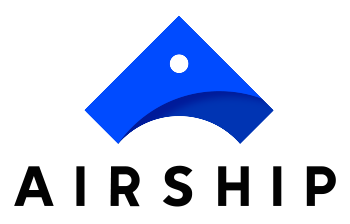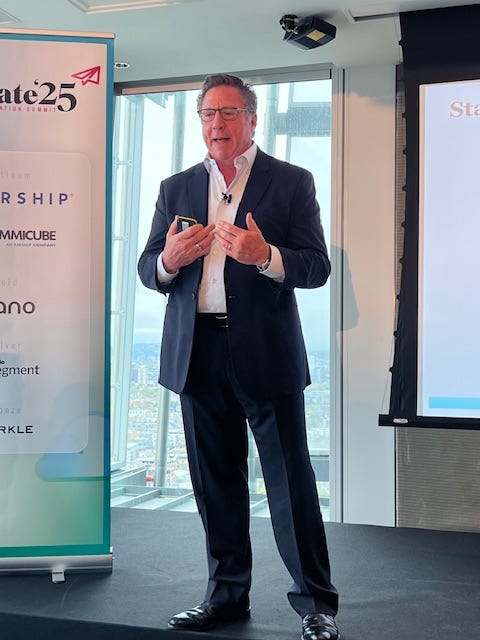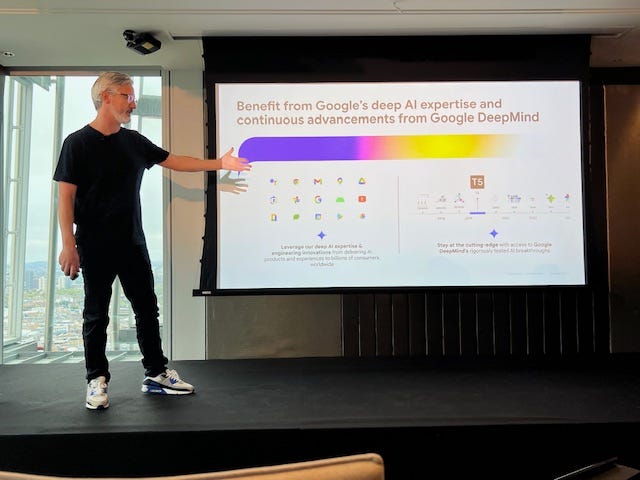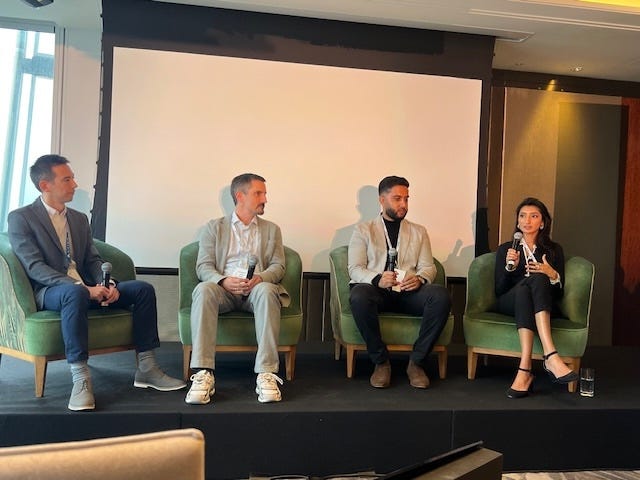Mobile Marketing's AI Reckoning: Inside Airship's Plan to Replace Campaign Chaos with Self-Optimizing Agents
As mobile traffic hits 66% of the global total, Airship Elevate25 revealed why most brands are still losing the mobile-first battle and how AI agent networks might finally turn the tide
The 66% stat everyone’s been ignoring just became impossible to avoid: that’s how much of global traffic now happens on mobile. At Airship’s London conference, over 200 marketing leaders learned why most of them are still getting it catastrophically wrong and how AI agents might finally fix it.
Here’s the uncomfortable truth that opened Airship Elevate25: your customers live on their phones, but your marketing stack was built for desktop. While you’ve been obsessing over email open rates and website analytics, the entire battleground shifted to mobile and most brands are fighting with outdated weapons.
Brett Caine, Airship’s CEO, didn’t mince words. “Mobile devices have become the remote control of our lives,” he told the sold-out crowd. “Every interaction is a moment to re-earn loyalty. Miss that moment, and you start over.”
The airlines figured this out years ago – boarding passes, gate changes, real-time updates that actually reduce anxiety rather than create it. The rest of us? Still catching up. And now there’s a new problem: traffic is collapsing.
Brett Caine, Airship’s CEO
The Revenue Paradox Nobody’s Talking About
Karen Franken from Piano dropped the day’s most counterintuitive stat: 70% of their publisher clients seeing traffic declines are growing revenue.
Let that sink in. Fewer visitors, more money.
The secret isn’t magic, it’s ruthless AI-driven propensity modeling that treats every single visit as precious. Piano scores users across three dimensions: likelihood to return, likelihood to register, likelihood to subscribe. The difference between low and high propensity segments? A staggering 200x conversion rate gap.
Giacomo Bernadi from Italian publisher RCS Group
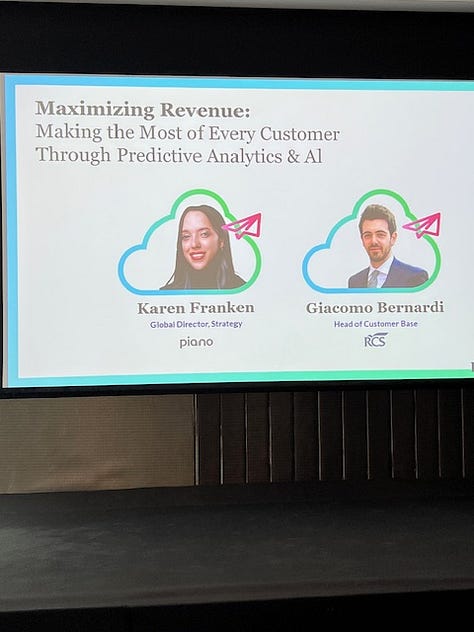
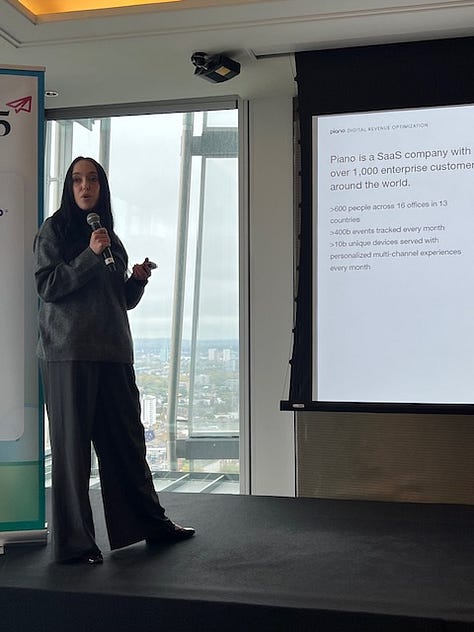
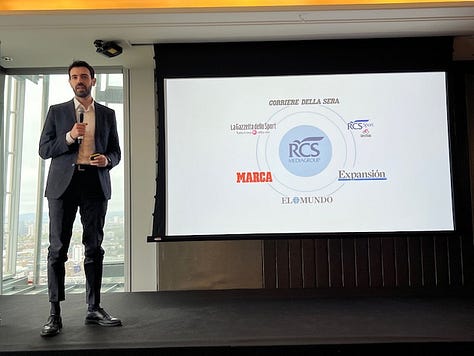
(720,000 digital subscribers) put numbers to it. When they tested Piano’s revenue optimizing model against their existing approach, they saw a 23% conversion rate increase and 21% total revenue boost. The trick? The system makes decisions at the page view level, not the user level. High-propensity subscribers hit paywalls. Low-propensity users viewing high-ad-value content see open pages maximizing ad revenue.
“We need to stop thinking about digital value and start thinking about company value,” Bernadi said. Translation: your subscription team and advertising team need to stop fighting and start collaborating around shared KPIs.
Google’s Uncomfortable Truth: Current AI Can’t Think Outside the Box
Tom Mason, Applied AI in the office of the CTO at Google Cloud, and the guy who launched Stable Diffusion at Stability AI, delivered the day’s most honest presentation. His opening question: “Are we at the beginning, middle, or end of the AI revolution?”
The audience voted “middle.” Mason’s answer? “I genuinely have no idea.”
Tom Mason, Applied AI in the office of the CTO at Google Cloud
What we do know, according to Mason, is that current AI has never produced what he calls “out-of-distribution thinking” ideas genuinely outside its training data. Einstein’s theory of relativity shifted human perception from 3D to 4D space. AI can’t do that. It can reason by talking to itself, refine outputs through iteration, but it can’t make the conceptual leaps that define true intelligence.
The breakthrough, Mason argued, requires two things: simulation and competition. His Science Studio tool can generate 100 innovative ideas in parallel (he demoed this live, feeding it a prompt about Airship features and watching it generate concepts like “Causal Journey Engine”). But without environments to test these ideas, they’re worthless. The future belongs to AI agents competing in simulated spaces, evolving faster than human oversight allows.
“Until agents can experience the world the way humans do by integrating multiple sensory inputs simultaneously, we cannot expect human-like intelligence,” Mason said. “Simulation provides that training ground. Competition ensures alignment.”
It’s a roadmap, not a solution. But at least someone’s being honest about the limits.
The Silo Problem Nobody Wants to Admit
A panel featuring Brendan Coelho from DAZN, Vibby Raj from BP Pulse, and Kristóf Fischer from One Hungary delivered the day’s most difficult truths about organizational dysfunction.
Fischer’s example was brutal: One Hungary’s sales reps get full commission for in-store transactions but lose out if they complete a digitally initiated sale. Result? 90% of sales still happen in physical stores despite years of digital investment. “Until commission models align with omnichannel behaviour, digital adoption will remain constrained,” he said flatly.
Coelho described DAZN’s solution: building a proprietary CDP that unified fragmented customer profiles, enabling real-time push notifications when a user’s favorite team plays but they’re not watching. Simple idea, complex execution requiring collaboration between product, data, and tech teams that often don’t speak the same language.
Raj’s point hit hardest: “A customer isn’t thinking about your fragmented tech architecture, but that is what is most difficult to get right.” For BP Pulse, connecting digital pre-arrival experiences (searching Google, planning routes) with physical EV charging requires real-time notifications bridging the gap—alerting when charges don’t start, thanking customers afterward. Basic stuff that’s astonishingly hard when your data lives in silos.
Jon Stewart from Airship, Brendan Coelho from DAZN, Vibby Raj from BP Pulse, and Kristóf Fischer from One Hungary
Fischer concluded with a reframe that should be tattooed on every CMO’s arm: “There is no such thing as accelerating digital value. There is only accelerated company value.” Until channels stop competing and start collaborating, you’re just rearranging deck chairs.
Airship’s Bet: An AI Agent Network That Actually Collaborates
While Google theorizes, Airship is shipping. CTO Mike Herrick unveiled the company’s most ambitious product evolution: a modular network of AI agents built on Google Cloud’s Agent Development Kit that don’t just execute tasks they collaborate.
Three agents are live in production right now. The Recommendation Agent analyses behavioural data and surfaces opportunities like “Enhanced Recent Customer Activation,” pulling from 16 years of Airship intelligence across verticals. The Brand Guidelines Agent ingests PDFs and ensures every piece of content aligns with brand identity. The Scenes Creation Agent generates high-fidelity in-app and website experiences from simple image uploads.
Mike Herrick, Airship CTO
But here’s where it gets interesting: these agents talk to each other. Soon, the Recommendation Agent will have a “Create Scene” button that triggers the Scenes Agent, which queries the Recommendation Agent for context, asks the Brand Guidelines Agent for styling rules, and autonomously creates a fully branded experience. Nobody explicitly programmed this workflow; it emerges from the network architecture.
Herrick demoed the Scenes agent live, uploading a “25% off” promotional image. Behind the conversational interface, dozens of specialized sub-agents collaborated, some generating images, others handling layout, others adjusting typography. The system iteratively rendered, compared results to the original, identified discrepancies, and refined until it achieved near-pixel-perfect recreation. The whole process took minutes.
“We had theoretical support for up to 27 A/B test variants for years,” Herrick admitted. “I think maybe one customer ever did that because it’s so hard to create that many variants. AI changes the calculus entirely.”
Five agents today will become 20 plus within two years. An Accessibility Agent launches soon to handle European Accessibility Act compliance automatically. The vision: marketing teams as orchestrators managing AI tools that generate hundreds of variants, continuously test and optimize, and handle compliance freeing humans for strategy and creativity.
CMO Maria Robinson emphasized what this means for Airship’s positioning against legacy players like Adobe, Salesforce, and Braze. “Many customers tell us they’re always looking for alternatives to those leaders because they want to do things differently and avoid lock-in on a single approach and platform,” she said. “They realize the world is increasingly in a mobile era.”
Airship is now in Gartner’s Magic Quadrant for Multichannel Marketing Hubs. Next up for them is Forrester’s Wave on Cross-Channel Marketing Hubs, especially since Forrester stopped doing their Mobile Engagement Automation evaluations where Airship was a leader.
Luisa Via Roma: When a 96-Year-Old Hat Shop Outpaces Digital Natives
Francesca Berretti delivered what might have been the day’s most surprising case study. Luisa Via Roma which started out selling straw hats in Florence back in 1929 now does 95% of its business online, shipping to over 150 countries. And they’re basically schooling digital-first brands on personalization.
How? They’ve gone all-in on integration. Their tech stack ties together Twilio Segment, Airship, Dynamic Yield, and Talon so that customer segments created in Segment automatically flow into Airship and update in real-time. When behavior shifts, messaging shifts with it.
The numbers are impressive: newsletters convert 50% better than direct traffic and bring in 20% of organic revenue. Push notifications? They’re driving 23% of app traffic and 25% of revenue. In one experiment with Vanity Fair, they segmented their Gold loyalty members and sent targeted offers across email, push, and SMS pulling in 300+ new magazine subscribers and boosting engagement everywhere.
Francesca Berretti from LuisaViaRoma
Berretti’s takeaway stuck with me: ‘Segmentation is everything. Without it, personalization is just window dressing. But don’t let automation kill your voice every message still needs to feel like your brand.’”
What Actually Matters
Strip away the jargon and Elevate25 delivered three actionable insights:
First, traffic volume is dead as a north star metric. Piano proved you can grow revenue while traffic shrinks if you obsess over per-visit value through propensity modeling and ruthless personalization.
Second, organizational structure matters as much as technology. BP Pulse, DAZN, and One Hungary all emphasized that data silos, misaligned incentives, and team dysfunction kill innovation faster than any technical limitation.
Third, AI’s value isn’t replacing humans—it’s enabling them to operate at a scale previously impossible. Airship’s agent network generates hundreds of variants, continuously optimizing, and ensuring compliance transforms marketers from manual creators into strategic orchestrators.
The brands winning today share common DNA: customer centricity, data fluency, collaborative structures, and willingness to test, fail, learn, and iterate fast.
As the conference wrapped, one thing became clear: mobile isn’t just a channel anymore. It’s the channel. And the gap between brands mastering mobile-first, AI-augmented experiences and everyone else is widening fast.
The question isn’t whether you’ll adapt. It’s whether you’ll do it before your customers stop giving you chances to get it right.



